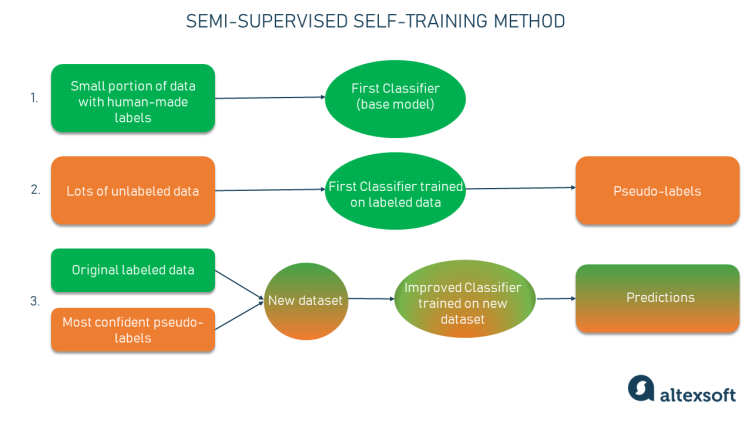
AI Atlas #11:
Semi-Supervised Learning
Rudina Seseri
🗺️ What is Semi-Supervised Learning?
Semi-supervised learning is a type of model training in which the machine learning model is trained using both labeled and unlabeled data. Labeled data refers to data that has been tagged or marked with a specific label or category that indicates what the data represents. Unlabeled data has not been tagged in this way and is thus raw and unstructured. Semi-supervised learning leverages a smaller amount of less-available labeled data alongside a larger amount of unlabeled data and is thus particularly useful in situations where obtaining labeled data is expensive or time-consuming, but unlabeled data is readily available.
The most common way to perform semi-supervised training is through a process in which a machine learning engineer utilizes both supervised and unsupervised training in what is called self-training. This involves:
Organizing the dataset into separate labeled and unlabeled sets.
Training the model on the labeled data through supervised learning. This means the model learns to predict outcomes based on the labeled examples provided.
Using the model to predict outcomes on the unlabeled data through unsupervised learning. These predictions may not be accurate as the model was not trained on this data.
Combining the labeled data with the predicted data (the previously unlabeled portion of the dataset that was labeled in step three) to create a larger dataset with more labeled examples.
Retraining the model on the combined data. This helps the model identify generalizable patterns and improve accuracy.
Repeating steps 3 to 5 multiple times with the model predicting outcomes on new unlabeled data, combining the predicted and labeled data, and retraining the model on the combined data until a desired level of accuracy is achieved or no further improvements can be made.
🤔 Why Semi-Supervised Learning Matters and Its Shortcomings
Semi-supervised learning helps address one of the key challenges in machine learning, the availability of labeled data. In many valuable applications of machine learning, obtaining large amounts of labeled data can be expensive, time-consuming, or impossible. Semi-supervised model training can overcome this challenge by leveraging additional unlabeled data, alongside a smaller amount of labeled data available.
Additionally, if the data labeled data available in the existing use case is biased or incomplete, semi-supervised learning can mitigate the effects of bias and provide a more comprehensive view of the underlying patterns and relationships in the data.
By solving these important training challenges, semi-supervised learning has many significant impacts including:
Improved Accuracy: By leveraging both labeled and unlabeled data, semi-supervised learning can improve the accuracy of machine learning models beyond what is possible with just labeled data
Reduced Labeling Costs: By generating labeling data as part of its training process, semi-supervised learning reduces the need for human labor.
More Generalizable Models: By leveraging unlabeled data alongside the labeled data, semi-supervised learning improves the generalization of the machine learning model.
Additional Data Insights: By using unlabeled data alongside labeled data, semi-supervised learning can help identify new patterns and relationships in the data that would not be possible using either dataset in isolation.
Improved Scalability: By reducing the required amount of labeled data, semi-supervised learning can help scale machine learning models to larger datasets and more complex problems.
As is the case with all techniques, there are limitations to semi-supervised learning including:
Dependence on Quality of Unlabeled Data: If unlabeled data is noisy, contains irrelevant information, or is not representative of the labeled dataset, it can negatively affect the performance of the model.
Limited Applicability: Semi-supervised learning often will not be the correct training approach when large amounts of labeled data is available or necessary to achieve the required level of accuracy.
Difficulty in Model Evaluation: Evaluating the performance of a semi-supervised model down to the data to identify sources of error is often more difficult since the model is trained on both labeled and unlabeled data.
Limited Interpretability: Semi-supervised models can be more complex and difficult to interpret than supervised learning models, particularly in deep learning, as it is a challenge to understand how the model is making predictions and identifying underlying patterns and relationships in the data.
🛠 Uses of Semi-Supervised Learning
Semi-supervised learning is useful for a wide range of applications including:
Computer Vision: By leveraging large amounts of unlabeled image data, semi-supervised learning can help improve the accuracy of computer vision models and reduce the need for manual labeling in tasks such as object detection, image segmentation, and scene understanding.
Anomaly Detection: By using both labeled and unlabeled data, semi-supervised learning can help identify patterns that may be difficult or impossible to identify with only labeled data.
Medical Diagnosis: Semi-supervised learning can use a small amount of labeled medical data, which is particularly expensive to acquire, in combination with more available unlabeled data.
Autonomous Vehicles: By using both labeled and unlabeled data from various sensors, such as cameras and lidars, semi-supervised learning can help improve the accuracy of object detection and recognition in complex and dynamic environments.
Quality Control: By using both labeled and unlabeled data, semi-supervised learning can help improve the accuracy of quality control models and reduce the need for manual inspection and labeling in manufacturing and industrials.
With the growing availability of unlabeled data and demand for more efficient and effective machine learning algorithms, semi-supervised learning will likely play an increasingly important role across domains fueling investment in developing new algorithms that can handle increasingly complex and diverse data.